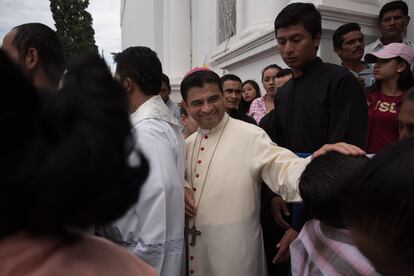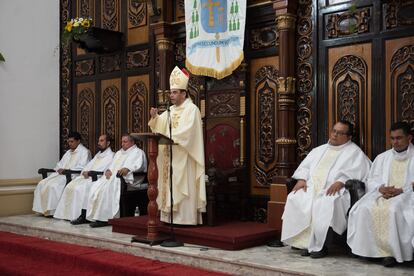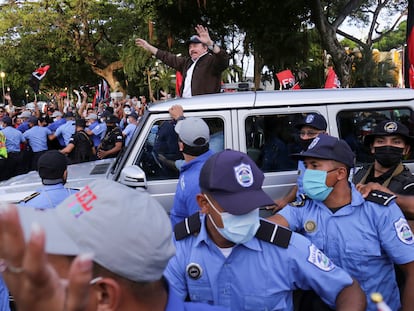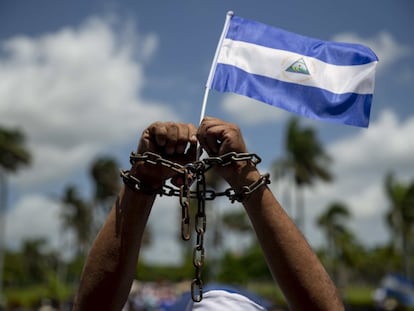A bishop against exile: reconstruction of the second failed attempt to expel Rolando Álvarez from Nicaragua
The Ortega-Murillo dictatorship has struggled to rid itself of a highly inconvenient political prisoner and its most outspoken clerical critic


Daniel Ortega and Rosario Murillo’s plan seemed simple – persuade Rolando Álvarez to leave the country. They tried leveraging “contacts” at the Vatican who were negotiating the release of the Roman Catholic priest who has been a longtime critic of the Sandinista regime and the Bishop of Matagalpa (central Nicaragua) since 2011. But the secretive and tense negotiations in early July were anything but simple. The plan to put Álvarez on a flight to Rome collapsed in under 30 hours in the face of his steadfast determination to remain in Nicaragua. Sentenced to 26 years in prison in February, the bishop unwaveringly asserts his innocence. He staunchly refuses to leave his homeland, contending that he has committed no crime.
This marks the presidential couple’s second attempt at getting rid of the bishop. In February, when 222 political prisoners were deported to the United States, Álvarez refused to board the plane into exile. His refusal foiled the regime’s attempt to quell a political backlash for imprisoning dissidents in deplorable conditions since June 2021, and fueled the ongoing outcry, both nationally and internationally, demanding his release and that of approximately 30 other political prisoners languishing in Managua.
When the first attempt to get rid of Álvarez failed, igniting the fury of Ortega and Murillo, the Bishop of Matagalpa was promptly sentenced to 26 years in prison for the political offense of “betrayal of the homeland.” Álvarez was placed under house arrest in August 2022, but was promptly transferred to a penitentiary after the trumped-up conviction. On the day of his sentencing, Ortega called Álvarez a “terrorist,” “madman” and “deranged.” Religious persecution in Nicaragua targeting Catholics quickly intensified.
The political analysts we interviewed say persecution of the Catholic Church ramped up dramatically. Holy Week processions were banned, nuns were deported, priests were arrested, churches were taxed and Catholic schools were closed. Sympathetic NGOs and media outlets were shut down. Bank accounts of Catholic dioceses and parishes were frozen to pressure the Vatican into removing the inconvenient bishop. But Álvarez’s plight has produced a wave of moral support for the church amid this oppression. According to a CID Gallup survey commissioned by Confidencial, a staggering 79% of Nicaraguans reject Álvarez’s conviction.

Secret negotiations
The Ortega-Murillo family finds itself severely isolated on the international stage because of their oppressive, totalitarian regime, and they have actively undermined bridge-building efforts. In March, the regime “suspended” diplomatic relations with the Vatican after Pope Francis likened the Sandinista government to a Hitlerian dictatorship. This effectively ended the Holy See’s capacity to advocate for the release of its bishop. Bishop Carlos Herrera, the President of the Nicaraguan Episcopal Conference (CEN) continues to push for dialogue with the government to secure Álvarez’s freedom, but his efforts have also been fruitless. During a visit to Rome in late June, Brazilian President Luiz Inácio Lula da Silva inserted himself in the stalemate and announced that he would negotiate Álvarez’s release.
The negotiations were shrouded in secrecy until diplomatic sources revealed on July 4 that Álvarez had been transferred out of La Modelo prison. Reports emerged of ongoing negotiations between the Nicaraguan government, the Vatican and the National Council of Bishops aimed at securing the bishop’s release. In the meantime, speculation regarding his whereabouts intensified.
EL PAÍS interviewed several diplomats and clergymen who said the negotiations were “tough and tense.” A delegate from the Vatican’s Secretariat of State participated in a video conference with the Sandinista government and the Nicaraguan bishops, but Álvarez reportedly persisted in rejecting the terms of his exile.
The negotiations crumbled as Álvarez adamantly held his ground, refusing to leave Nicaragua and insisting on the unconditional release of all priests who had been convicted by the Ortega-Murillo regime, including himself. Additionally, he pressed for the dioceses, parishes, and priests’ bank accounts to be unfrozen. The presidential couple dismissed every demand.
Cardinal Leopoldo Brenes, in his usual timid manner, attempted to downplay the failed negotiations. He provided statements to select media outlets dismissing the reports of Álvarez’s release as “pure speculation.” The cardinal said Álvarez remains incarcerated in La Modelo prison and criticized all the media coverage. Brenes also made it clear that he has had no contact with Álvarez, his brother in faith who remains a political prisoner.
Álvarez firmly maintained that he would depart Nicaragua solely upon receiving explicit directives from Pope Francis. However, it has not been confirmed whether the Pontiff issued any specific order in this regard. “Francis hasn’t told him to leave his country and travel to Rome, neither before nor during this negotiation,” said our diplomatic source. As a result, the bishop maintained his unwavering intent to stay in Nicaragua, exhausting all avenues of negotiation. Álvarez was returned to La Modelo prison on July 5 where he has been held in isolation since February.
Sign up for our weekly newsletter to get more English-language news coverage from EL PAÍS USA Edition
Tu suscripción se está usando en otro dispositivo
¿Quieres añadir otro usuario a tu suscripción?
Si continúas leyendo en este dispositivo, no se podrá leer en el otro.
FlechaTu suscripción se está usando en otro dispositivo y solo puedes acceder a EL PAÍS desde un dispositivo a la vez.
Si quieres compartir tu cuenta, cambia tu suscripción a la modalidad Premium, así podrás añadir otro usuario. Cada uno accederá con su propia cuenta de email, lo que os permitirá personalizar vuestra experiencia en EL PAÍS.
¿Tienes una suscripción de empresa? Accede aquí para contratar más cuentas.
En el caso de no saber quién está usando tu cuenta, te recomendamos cambiar tu contraseña aquí.
Si decides continuar compartiendo tu cuenta, este mensaje se mostrará en tu dispositivo y en el de la otra persona que está usando tu cuenta de forma indefinida, afectando a tu experiencia de lectura. Puedes consultar aquí los términos y condiciones de la suscripción digital.
More information
Archived In
Últimas noticias
Most viewed
- Sinaloa Cartel war is taking its toll on Los Chapitos
- Oona Chaplin: ‘I told James Cameron that I was living in a treehouse and starting a permaculture project with a friend’
- Reinhard Genzel, Nobel laureate in physics: ‘One-minute videos will never give you the truth’
- Why the price of coffee has skyrocketed: from Brazilian plantations to specialty coffee houses
- Silver prices are going crazy: This is what’s fueling the rally










































